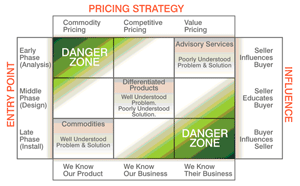
Staffing the sales function with sales representatives that have broadly defined “selling” skills is no guarantee of success. It may not even be enough to deploy sellers with skills adapted to the unique markets they compete in.
Sales forces with the best likelihood of success are those that know when, where, and with whom to apply their market-appropriate selling skills. How do sales organizations know “when”, “where”, and “with whom” to engage? They carefully align their sales processes to buyers’ expectations.
By analyzing buyer behavior and preferred buying processes, sales forces can craft sales processes that have the best chance of success in their unique marketplace. In this article, author and practicing sales manager Wayne Gillikin outlines a unique and practical way to ensure your sales force is selling in sync with how your customers and prospects expect to buy.
1. Unified Solutions Acquisition Model
Though not often apparent to sales organizations, the process buyers expect to engage in with suppliers is not the same for all purchases.  Instead, buyers come to market with different expectations for how they would purchase desired products or services. An often overlooked, though intuitively obvious characteristic of high-performing sales organizations: they make it easy for buyers to buy, first by understanding how buyers expect to make purchases, then by building a selling methodology around those expectations.
Gaining insight into how buyers expect to buy is best done with a structured methodology. This paper outlines one such methodology, the Unified Solutions Acquisition Model, or USAM. USAM allows businesses to understand how the prospects in their target market expect to purchase products like theirs.
As an example, consider the differences in the following buying processes: a bid solicitation, an impulse purchase, and a trusted referral.  In a bidding process, the buyer requests price quotes from a few potential vendors and selects the vendor with the lowest price. An individual might select a vendor to resurface their driveway or paint their house using the bid process. Other purchase processes are more impulsive. That is to say, when the requirement emerges the buyer selects the nearest vendor because, in general, all vendors are basically equivalent. You might select a gasoline station this way. Finally, there are classes of purchases where the buyer reaches out to, and makes contact with, a vendor recommended buy a trusted source. Assuming you had a choice, this is probably the way you would select a physician.
In each of these processes the buyer came to the market with different expectations about how they would purchase the products or services they wanted. Indeed, the greater the misalignment between a seller’s selling methodology and buyers’ purchase process expectations, the less efficient will be their interaction. If the seller’s sales tactics are not in alignment with the buyer’s purchasing tactics, the seller’s ability to promote a value proposition will be diminished. Competitors with a sound understanding for prospects’ purchase process expectations interface with buyers more efficiently. The more efficient this “interface,” the easier sellers will find it to communicate a value proposition to buyers. (see Figure 1).

Figure 1:Â The purchase event interface
Consider a gas station whose customers purchase in the impulsive manner described above. If a gas station owner made the mistake of thinking that individual consumers would purchase a tank of gasoline the way they purchase driveway sealing and resurfacing, the business would be long gone before an RFP was received for a tank of gas. How a vendor tactically sells, i.e., how the vendor’s sales representatives engage clients, is the vendor’s “selling methodology.” The selling methodology for a retail gasoline outlet would, in large part, have to do with location. The gasoline needs to be where the cars are when the cars need refueling. If the gasoline station owner hired a sales rep to contact potential retail buyers and attempt to sell them gasoline, the buyer receptiveness would be very low; they expect to purchase gasoline when and where they need it, from a convenient vendor. A retail gasoline vendor must align their selling methodology to the purchase process expectations of the buyer. If there is alignment between purchase process expectations and the selling methodology then the purchase event interface is efficient, communication is facilitated, and the seller’s value proposition flows across the interface unimpeded by model misalignment.
2. The Purchase Event Interface
Let’s take a closer look at the purchase event interface and see what is driving both the buyer’s and the seller’s perspective.
At the heart of the Unified Solutions Acquisition Model is the purchase event interface. When a buyer is ready to buy they expect to deal with a seller who is prepared to sell. The communication across the interface between the buyer and the seller is based on a common appreciation for what is required to make the purchase happen. The point of contact between the buyer and seller is the purchase event interface. The tactical image for the buyer is their purchase process expectation and the tactical image for the seller is their selling methodology. The “tactical image” is a set of tactical behaviors that is derived from a critical function. The “critical function” is a more general or strategic condition resulting from the values of function arguments. [This relationship can be represented mathematically by the following function notation: f(x1, x2, …xn)=y, where f is the critical function, xn represents a function “argument†and y is the output, result, or “image” of the function.]
Critical Functions and Function Arguments
The buyer goes into the marketplace to acquire a solution to a problem or need. The problem can be anything from a headache to a need to run electrical equipment; the solution can be anything from an analgesic to a nuclear power plant. An efficient purchase event interface relies on the proper alignment of tactics (viz. purchase process expectations and selling methodology).
Since tactics derive from strategy, the buyer’s strategy and seller’s strategy ought to be in alignment as well. USAM identifies the buyer’s and seller’s strategy as critical functions. On the buyer’s side, the critical function is how prepared they are to make an informed purchase decision. USAM refers to this buyer-side critical function as “buyer preparedness.â€Â The critical function on the seller’s side is their sales strategy (Figure 2).

Figure 2:Â Critical Functions
Each critical function is controlled by its own unique set of function arguments. Each of these independent function arguments can take on various values. In other words, the state of the buyer’s or seller’s strategy (i.e., their critical function) can change depending on the values of the individual function arguments at any time.

Keep in mind a “fundamental postulate” of selling: “The seller can’t control the sale – only how they sell.” That means that if the seller is gong to be successful they will need to know how their prospects buy and why they buy that way. Once the seller has done careful, objective analysis, and possesses an accurate image of their target market’s purchase process expectations, they will be able to develop strategy and tactics to balance the model and make the purchase event interface efficient. Sellers who ignore this could end up like our gas station owner who expects to get an RFP for a tank of gas.
Let’s examine the sets of buyer’s and seller’s function arguments to see how they impact strategy and tactics. First we will consider the buyer’s critical function of buyer preparedness and see how their strategy is controlled by the buyer’s function arguments.
Buyer Preparedness
On the buyer’s side, buyer preparedness is controlled by two function arguments. The first function argument is how much the buyer knows about their particular problem. The second function argument is how well the buyer understands the solution (Figure 3).
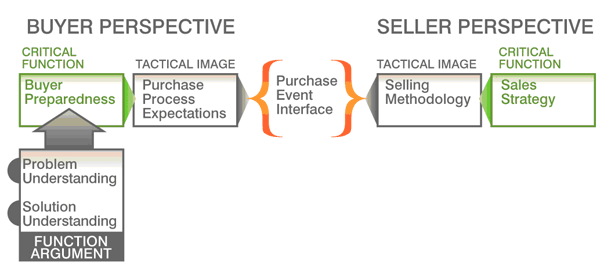
Figure 3: Buyer’s function argument
It may seem irrational that a buyer would make a purchase without understanding the problem or the solution, but it happens all the time. Consider what happens when you feel ill. Do you know what the problem is? Can you name the range of diseases that are indicated by your set of symptoms? Do you know what tests are required to narrow down the likely diseases? Do you know the range of treatments for the likely diseases? Unless you are a trained physician the answer is certainly no. What do you do? You purchase the services of a trusted advisor – you go to a doctor. You didn’t understand the problem or the solution but you went into the marketplace and made a rational purchase anyway.
For illustrative purposes we will consider that the two function arguments – “understands the problem,” and “understands the solution” – have binary values. That is, they are either “yes” or “no.” That leaves us with four possible outcomes as shown in Figure 4.
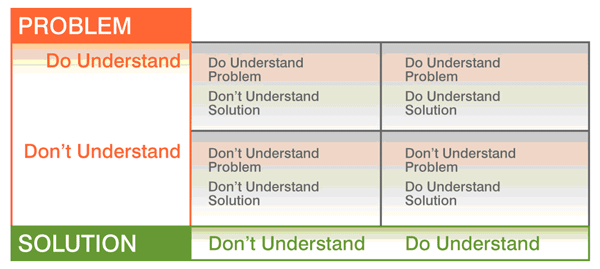
Figure 4:Â Buyer’s function argument
Let’s look at the lower right quadrant first, since it reflects irrational behavior and we need to eliminate it immediately since USAM assumes rational buying behavior.
Understanding the solution but not the problem is like saying “I don’t understand the physiology (causal linkages) of pain, but I notice that when I stop hitting myself in the head with a hammer I seem to feel better.” Because you don’t understand the causal linkages you rely on elements of faith regardless of how correlated the results are. Without understanding the causal link we take it as an article of faith that what has worked in the past will work again in the future. This may be effective for the “Hammer-Head” example but not so effective in business.
Rational business people strive to understand the causal linkages between actions and outcomes. In business, if we didn’t understand the causal linkages, we would not know how much of the solution to apply, or when to apply it, or when to stop applying it. Assuming that business people run their businesses based on reason, not faith, we will eliminate the lower right quadrant as a rational condition of buyer preparedness. That leaves us with three remaining rational conditions of buyer preparedness shown in Figure 5.
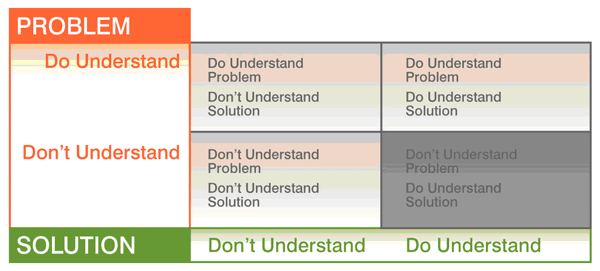
Figure 5:Â Rational conditions for buyer preparedness
Sales Strategy
We’ll now turn our attention to the seller’s side of the purchase event interface and look at what drives their critical function of sales strategy. We are making a distinction between sales strategy (critical function) and selling methodology (tactical image) here. The distinction is simply between the strategic and the tactical. Sales strategies are strategic, while selling methodologies are tactical. Selling methodology flows from sales strategy.
Sales strategy is controlled by four function arguments (see figure 6). These arguments are:
1.   Pricing strategy.
2.   The level of influence the seller has in the solution acquisition process.
3.   How much insight the seller is required to have?
4.   When does the seller get involved in the solution acquisition process

Figure 6:Â Seller’s function argument
For illustrative purposes each sales side function argument takes on one of three values: high, medium or low. Let’s look at each argument individually.
The Influence Argument
The “influence argument” has to do with how much influence the seller is able to exert over the solution acquisition. The highest level of influence is where the seller influences the buyer’s decision process from the point where the buyer begins thinking about the problem through the point where they make a purchase decision. The seller might also exert a medium level of influence where they educate the buyer about solution options. Finally, at the lowest level of influence, the prospect actually influences the seller. That happens when the seller enters the deal after all decisions are made and the buyer knows exactly what they want as is typical in commodity markets.
The Price Argument
Pricing strategy breaks down similarly to:
1.   Commodity Pricing
2.   Competitive Pricing
3.   Value Pricing
The levels of pricing roughly relate to available margin. In commodity pricing the margin is relatively low and the prices are very similar and tend to be sticky. Commodity pricing conforms to the economic model for pure capitalism or pure competition. In this model there are lots of buyers and sellers and the products are largely un-differentiable. Competitive pricing, by contrast, has higher margins because the products are differentiable. Indeed, pricing is based on the product’s or service’s differentiators and the marginal value they provide to the customer, as compared to competing products. Value pricing is the highest margin pricing scheme. This is based on the value provided without regard to competitive products. This is the pricing model for subject matter experts, thought leaders, and gurus.
The Entry Point Argument
“Entry point” describes the point at which the seller gets involved in the solution acquisition process. The phases of the acquisition process are:
1.   Early Phase – the buyer is analyzing the problem.
2.   Middle Phase – the buyer is designing a solution.
3.   Late Phase – the buyer is acquiring the solution.
In the process of acquiring a solution the first and earliest stages are where the buyer analyzes the problem space. First the buyer has to figure out what is wrong. Then they need to design a reasonable solution in the middle phase. Finally, the buyer needs to acquire and implement the solution. The process of making an acquisition proceeds along the path of standard “waterfall” engineering methodologies: analysis, design, and implementation. Many solution acquisitions explicitly engage each phase of the process while others start and finish at implementation. It is critical for a seller to know precisely at which stage a buyer will engage with them.
The Insight Argument
Insight means how much the seller needs to know to support the buyer’s effort to make an acquisition decision. The three levels of Insight are:
1.   Seller knows their product
2.   Seller knows their business
3.   Seller knows the buyer’s business
Insight at level 1 is illustrated by a wholesaler providing electrical parts to an electrical contractor (EC). The EC needs a dozen household-quality, grounded, duplex outlets. He looks at the wholesalers catalog, jots down the part number, calls the wholesaler and orders the parts. The wholesaler doesn’t render a judgment as to the suitability of the part number for the application; it simply fills the order.
If, at level 2, the vendor is selling a general accounting package, the sales rep would need to know a fair bit about the actual application and how it differs from the competitions.’Â In general, it is not necessary to consider whether the customer is in the business of men’s shoes or lady’s handbags.
At the highest level, however, it is important that the seller know each product in detail, and also know exactly how effective each alternative solution will be in specific business environments. Consider a security consultant. The solution they might recommend for a homeowner would be very different, in ways other than size, than a solution they would recommend for a school, or a bank. Levels of increasing insight require increasing levels of expertise and education – which come at increasing levels of cost. Matching the right level of insight to the market requirement is essential.
Balancing Function Arguments
At this point we have described a system that requires balance between the buyer’s perspective and the seller’s perspective. Each side has a tactical image controlled by the critical function which, in turn, is driven by function arguments which must be in alignment with each other and between perspectives.
For the buyer the critical function is buyer preparedness, which is controlled by the function arguments of (1) problem understanding; and (2) solutions understanding.
For the seller the critical function is sales strategy, which is controlled by the function arguments of:
•   Pricing,
•   Influence,
•   Insight, and
•   Entry Point.
As depicted in Figure 6, the output of the critical function buyer preparedness is a tactical image of purchase process expectations; and the output of the critical function sales strategy is the tactical image of selling methodology. Selling methodology and purchase process expectations meet across the purchase event interface and must be in sync. However, in order for the purchase process expectations and selling methodology to be in sync all function arguments must be in alignment. This point of “function argument alignment” is foundational and is the key to synchronizing tactics at the purchase event interface.
Sellers must take the initiative to fully understand the buyer side function arguments in order to align seller side function arguments and adopt a sales strategy that produces a selling methodology in sync with the buyer’s purchase process expectations (Figure 7).
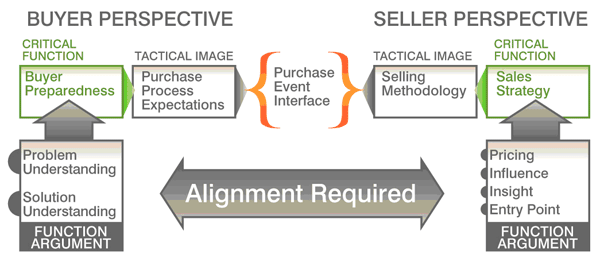
Figure 7: Aligning Perspectives
Now that we have established the inputs or function arguments and the need for alignment, it remains to understand how these function inputs interact in a dynamic environment.
Aligning Function Arguments
USAM is a system that requires balance. It is incumbent upon sellers to adjust their strategy to meet the purchase process expectations of the buyer. In order to better visualize this alignment we will bring both the buyer’s and seller’s perspectives (function arguments) together in a single illustrative framework.
Seller’s Function Arguments
First let’s look at the seller’s function arguments. For illustrative purposes we can set up the seller’s function arguments on a coordinate system to help us visualize how function arguments produce various sales strategies. This coordinate system is depicted in Figure 8. As can be seen, each of the four function arguments is represented on an axis. Each of the three possible values of each argument is also shown in the respective axis. This gives us a grid with nine quadrants. Each quadrant on the grid represents a particular set of values for the function arguments and, therefore, a unique sales strategy.
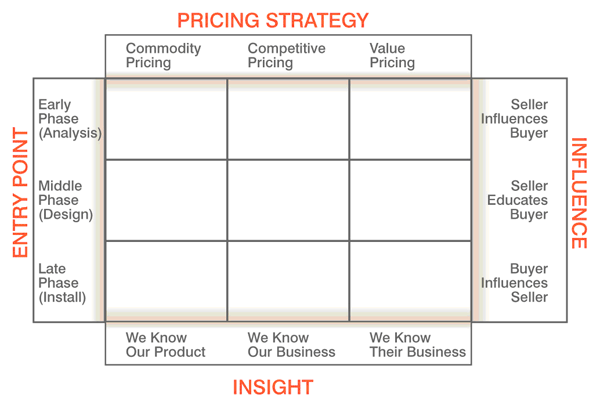
Figure 8:Â Seller’s function argument
Let’s consider some of the various positions on the grid and see what those positions suggest about a sales strategy.
First, let’s look at the lower left position of the grid. The values of the function arguments are as follows
•    Entry Point: The seller gets into the deal very late; during the implementation phase.
•    Insight: The seller does not know very much other than some information (technical data) specific to the seller’s product.
•    Price: The seller is providing commodity pricing
•    Influence: Basically, the seller influences nothing. In this case the buyer exerts greater influence over the seller. The buyer tells the seller what make, model, and quantity of widget is required and lets the seller know that if their price is the lowest they will get the deal.
This is a perfectly rational set of function argument values. A wholesale electrical supply (as described earlier) selling largely undifferentiated products (e.g. electrical outlets) to electrical contractors (ECs) would expect to be in this space on the grid. They would expect ECs to call, just as their need arises, with exact specifications, and tell the supplier the part numbers and quantities required. The EC would not expect the supplier’s sales people to know which is the best product for their application and will simply tell the supplier that if they have the lowest price they will get the business. This is a commodity market. Many very successful companies operate in this space on the grid.
Now let’s look at the middle square of the grid. That is where the seller would operate if they had a differentiated product like, for example, modular office furniture. Here the seller would expect to get involved in the acquisition process after the buyer knew that they needed furniture but while the buyer is still trying to figure out which solution is best. The seller needs to know a lot about how the product functions and is used, but, not the differences in utilization between, say, an accounting firm and an insurance company. The values of the function argument at this point on the grid are as follows:
•    Entry Point: The seller gets into the deal in the middle phase where the buyer is trying to get a handle on various solution options.
•    Insight: At this point the seller is required to have more insight into the detailed characteristics of the product. The seller does not need to know exactly how it addresses the idiosyncrasies of the buyer’s business but the seller does need to know how and why the product does what it does and recommend the right set of options to get the job done.
•    Price: Here the seller is providing competitive pricing consistent with the strength of their value proposition.
•    Influence: In this instance the seller does have some ability to influence the deal. The seller can educate the customer on how well the product does what it does and why it is a better solution to the problem than alternative choices.
This is the market for differentiated products and many successful companies operate in this quadrant on the gird.
Now let’s look at the upper right square of the grid. The values of the function argument are as follows:
•    Entry Point: The seller gets into the deal while the buyer is trying to understand the true nature of the problem.
•    Insight: At this point the seller needs to have a great deal of insight not only into the idiosyncrasies of the buyer’s business but also the pros and cons of alternative solutions.
•    Price: Here the seller is able to price based on the value provided to the buyer. The value to the buyer is based on the amount of revenue the seller can help the buyer generate or cost (or risk) the seller can help the buyer avoid based on the seller’s keen insight and subject matter expertise.
•    Influence: The seller influences the entire solution acquisition process. The seller is a trusted advisor and will be able to drive the deal in any reasonable direction.
This space is where subject matter experts (consultants) live. This is the market for advisory services.
In each of the three locations on the grid (viz. lower left, center, and upper right) we identified different, broad, product categories that were represented by each location. The product categories we identified were commodities, differentiated products, and advisory services. If we look at Figure 9 we can see how the three product categories fit into the grid of the seller’s function arguments. Each position represents a perfectly rational set of function arguments. Further, each product category necessarily represents a different sales strategy.
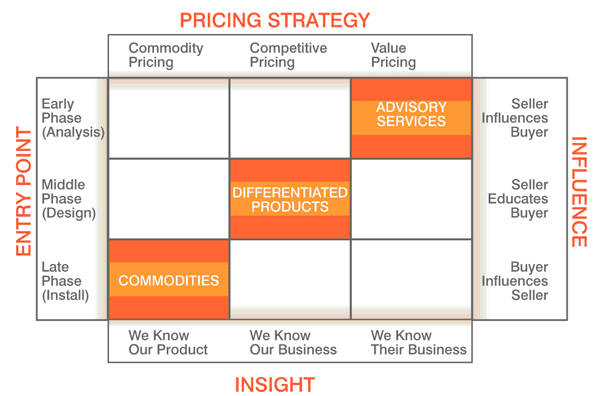
Figure 9:Â Product Categories
Integrating Seller’s & Buyer’s Function Arguments
The seller’s function arguments have to be in alignment with the buyers function arguments as depicted in Figure 7. Now, if we look at figure 10 we can see that the three rational conditions of buyer preparedness fit neatly into the three product categories described above. It should make some sense that when a buyer poorly understands the problem and poorly understands the solution they will seek assistance in the form of advisory services form a subject matter expert. This was illustrated earlier through the example of going to a physician when we feel ill. On the other hand when the buyer understands the problem and solution well they don’t require much in the way of service from the seller and expect to buy in a commodity market. This idea even conforms to the macro-economic model. As described earlier the commodity markets very closely resemble pure capitalism. One of the defining properties of pure capitalism is that buyers have full knowledge. And, indeed, in our commodity market we assume they have.
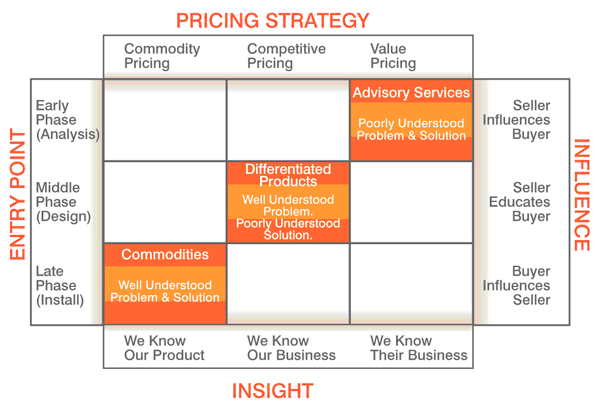
Figure 10:Â Buyer Preparedness
If we combine Figure 9 and Figure 10 we can see that in each of the three shaded squares the buyer’s preparedness and the seller’s strategy derive from critical functions with aligned sets of function arguments. As long as the buyers and sellers use this strategy to formulate market-appropriate tactics, the purchase event interface will operate at maximum efficiency in each case.
For the purposes of this analysis we are going to assume that buyers know how to purchase. That is to say, we are not going to wrestle with the possibility of a retail gasoline buyer who wants to get three bids for a tank of gas or other such market-inappropriate purchase process expectations. We will focus the remainder of the analysis on the seller and how they can get into trouble when they are not properly located on the USAM grid.
The first problem for sales organizations comes when they stray too far from the zone of optimal efficiency depicted in Figure 11. Rational buyers and markets simply don’t operate in the upper left and lower right sections of the grid hence sellers can’t survive there either.
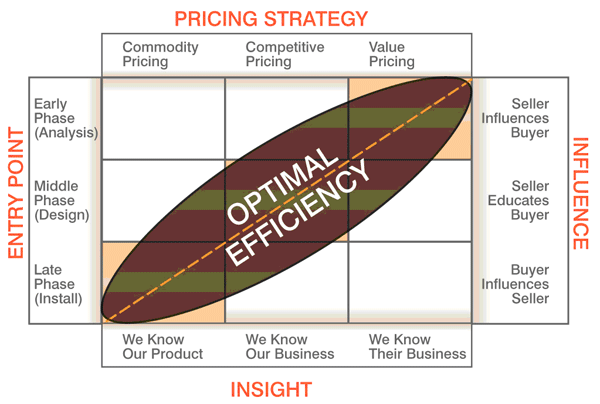
Figure 11: Zone of Optimal Efficiency Â
Irrational Solutions
Consider operating in the upper left corner of the grid. A sales organization would expect to enter the deal at the very earliest phase and have a great deal of influence over the process but would not have invested very much in amassing the appropriate levels of knowledge or insight and would have commodity pricing. This represents an irrational set of function arguments.
Now consider operating in the lower right corner of the grid. A sales organization doesn’t expect to enter the deal until the late phase, where they expect not to exert any influence, but have invested a great deal of energy and resources gaining insight, with the expectation of achieving value pricing. This is also an irrational set of function arguments. These corner solutions do not represent sets of function arguments that are either efficient or rational. Both of these corners represent danger zones for sales organizations.
Argument Misalignment
Sales organizations also get into trouble when one or more function arguments are out of alignment with others. For example, consider selling a commodity and the entry point argument, influence argument, and product insight argument have the appropriate values. However, the seller has decided to price higher than the market. Since commodity markets act like true capitalism we know that prices only trend downward. If seller raises their price above the market no one will buy from them and their competitors will not follow the pricing strategy. If the seller lowers their price the market will only buy the lower priced commodities so all competitors will immediately follow the price decrease. Think about how neighborhood gasoline price wars operate. The result of lowering the price would be margin erosion, no increase in total units sold, and a decrease in total profit. All participants in commodity markets price with their competitors as prices are dropping; but if a competitor raises their price the other suppliers will simply stand back and watch them starve to death.
Model Imbalance
The third way a seller can get into trouble is to find a location on the grid that is not co-inhabited by the buyers who are their prospects. An extreme example: the gas station owner using outbound selling to gain customers. That example was admittedly ludicrous. However, organizations often make decisions on selling methodology that have no relationship with a market-appropriate sales strategy. This syndrome is prevalent in many American businesses. The problem usually is one of trying to sell farther up and right on the USAM grid than is appropriate for the market. The motivating factor is the greater margins that can be achieved by moving up and right. Unfortunately, you can’t fool the market.
The basic point is that a seller can operate profitably and effectively anywhere in the zone of optimal efficiency provided that values of all their function arguments converge at a single point on the USAM grid, and their prospects’ purchase process expectations are aligned with their selling methodology as in Figure 12.
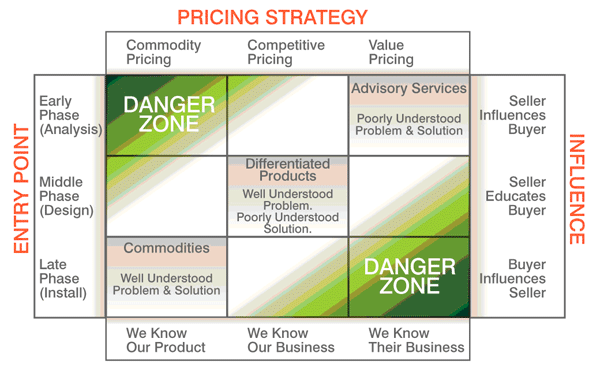
Figure 12:Â Unified Solutions Acquisition Model
Conclusions
Figure 12 represents the Unified Solutions Acquisition Model (USAM). It draws together the function arguments for both the buyer and seller and integrates them into a single, unifying model of sales strategy. It is for this reason that the model was developed – not as a sales model but rather as a Solutions Acquisition Model. In so doing it is possible to integrate both the buyer’s perspective and the seller’s perspective across the spectrum of purchase process expectations. The goal is to allow sales organizations to better understand how their prospects expect to make purchases. Following that understanding it will be possible for a sales organization to build a sales strategy in sync with their market.
The model is simplified for illustrative purposes but represents, nonetheless, a sound depiction of how sellers and buyers interact. For many real world “solutions” the “acquisition” process may be quite complex. Acquiring these solutions can require numerous purchases and cover all rational levels of preparedness. Because USAM accommodates more complex solution acquisitions it is possible to show how individual products and/or services, which may represent only a small component of a much larger solution, are acquired.
One may take from this distilled description of the Unified Solutions Acquisition Model a few basic principals:
- Buying tactics – purchase process expectations, and selling tactics – selling methodology, must be in sync if buyer/seller interaction is going to be efficient. That is, if the purchase event interface is going to be efficient
- Successful, profitable, businesses operate everywhere in the zone of optimal efficiency. Make peace with your market and learn how to be profitable in it. You can’t fool the market.
- The farther from the zone of optimal efficiency a selling organization is, the greater will be their misalignment with any buyer’s purchase process expectations.
- Wherever the targeted prospect community exists on the grid you can be assured that there will be sellers waiting with function arguments optimally aligned with the buyer’s. The optimally aligned selling organizations will win.
- There are three ways sellers lose at this game:
- Wander off into the danger zones.
- Develop a sales strategy based on function arguments that do not all meet at the same point on the USAM grid.
- Have a set of function arguments that all meet at the same point on the USAM grid (good), are not in the danger zones (good), but, are not collocated with the targeted prospect population on the USAM grid.
- Don’t try to fool the market. If you are aligned it is good and if you are not it is bad. No amount of self-serving mental contortions will turn a commodity into a differentiated product. Do good, careful, objective analysis. If it quacks and its feet are webbed…
About The AuthorÂ
Wayne Gillikin has held a variety of sales leadership roles throughout his 25 year sales career. During that time he has participated in both emerging and mature markets within the IT sector as well as the Maritime Industry and Homeland Security.
Mr. Gillikin can be reached for comment by email at [email protected] or by phone at 973-633-6837.









